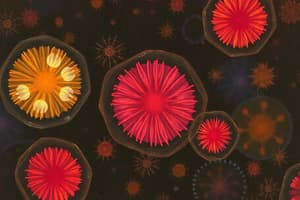Podcast
Questions and Answers
¿Cuál de los siguientes organelos es responsable de la síntesis de proteínas?
¿Cuál de los siguientes organelos es responsable de la síntesis de proteínas?
- Ribosomas (correct)
- Lisosomas
- Aparato de Golgi
- Mitochondria
¿Cuál es la función principal del aparato de Golgi?
¿Cuál es la función principal del aparato de Golgi?
- Generación de energía
- Degradación de residuos
- Modificación, clasificación y embalaje de sustancias (correct)
- Síntesis de proteínas
¿Cuál es la relación entre el retículo endoplasmático y el núcleo?
¿Cuál es la relación entre el retículo endoplasmático y el núcleo?
- El retículo endoplasmático se encuentra cerca del lisosoma
- El retículo endoplasmático se encuentra cerca del aparato de Golgi
- El retículo endoplasmático rodea al núcleo
- El retículo endoplasmático comparte parte de su membrana con el núcleo (correct)
¿Cuál es la función principal de las mitocondrias en la célula?
¿Cuál es la función principal de las mitocondrias en la célula?
¿Cuál es la función de los lisosomas?
¿Cuál es la función de los lisosomas?
¿Qué orgánulo es responsable de la descomposición de residuos celulares?
¿Qué orgánulo es responsable de la descomposición de residuos celulares?
¿Cuál es la función del retículo endoplasmático liso?
¿Cuál es la función del retículo endoplasmático liso?
¿Cuál es la función de los ribosomas en la célula?
¿Cuál es la función de los ribosomas en la célula?
¿Qué estructura se forma mediante los pliegues de la membrana interna de la mitocondria?
¿Qué estructura se forma mediante los pliegues de la membrana interna de la mitocondria?
¿Cuál es la función de las mitocondrias?
¿Cuál es la función de las mitocondrias?
¿Cuál es el nombre del orgánulo que se encarga de procesar y transportar proteínas?
¿Cuál es el nombre del orgánulo que se encarga de procesar y transportar proteínas?
¿Cuál es el orgánulo que contiene enzimas que rompen las moléculas de residuos celulares?
¿Cuál es el orgánulo que contiene enzimas que rompen las moléculas de residuos celulares?
Flashcards are hidden until you start studying
Study Notes
Organelles are specialized subunits within a cell that perform specific functions. In eukaryotic cells, various organelles contribute to the overall cellular processes, such as protein production, processing, and transport. This article focuses on the subtopics of organelles: mitochondria, lysosomes, ribosomes, golgi apparatus, and endoplasmic reticulum.
Mitochondria
Mitochondria are often referred to as the "powerhouses" of the cell because they are responsible for generating energy in the form of ATP (adenosine triphosphate) through cellular respiration. They are oval-shaped organelles found in most eukaryotic cells, with a double membrane structure that creates five distinct compartments. The outer membrane, inner membrane, intermembrane space, cristae (formed by infoldings of the inner membrane), and matrix (space within the inner membrane) all play essential roles in cellular respiration.
Lysosomes
Lysosomes are membrane-bound organelles that act as the cell's digestive component. They contain enzymes that break down proteins, polysaccharides, lipids, nucleic acids, and even worn-out organelles. The lysosomal enzymes work by hydrolyzing, or breaking down, the cell's waste products, helping to maintain cellular health and functionality.
Ribosomes
Ribosomes are the protein factories of the cell. They are composed of two subunits and can be found floating freely in the cell's cytoplasm or embedded within the endoplasmic reticulum. Using the templates and instructions provided by two different types of RNA, ribosomes synthesize a variety of proteins that are essential to the survival of the cell.
Golgi Apparatus
The golgi apparatus is responsible for modifying, sorting, and packaging different substances for secretion out of the cell or for use within the cell. It is found close to the nucleus of the cell and processes proteins that have been delivered from the rough endoplasmic reticulum. The golgi apparatus can be thought of as a post office, as it packages and labels "items" and sends them to different parts of the cell.
Endoplasmic Reticulum
The endoplasmic reticulum is a membranous organelle that shares part of its membrane with the nucleus. It has two main parts: the rough endoplasmic reticulum and the smooth endoplasmic reticulum. The rough endoplasmic reticulum is studded with ribosomes and is involved with protein manufacture, while the smooth endoplasmic reticulum serves to produce vital lipids (fats) and is found in both animal and plant cells.
In summary, these organelles work together to maintain the overall health and functionality of a eukaryotic cell. Proteins are produced in the rough endoplasmic reticulum, modified and packaged in the golgi apparatus, and then sent to their proper destinations in the cell. Mitochondria generate energy, lysosomes break down waste products, ribosomes synthesize proteins, and the endoplasmic reticulum is involved in both protein production and lipid synthesis. These organelles contribute to the complex and intricate processes that occur within a eukaryotic cell.
Studying That Suits You
Use AI to generate personalized quizzes and flashcards to suit your learning preferences.




